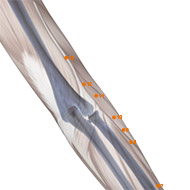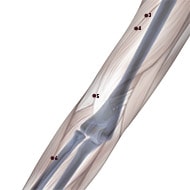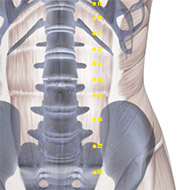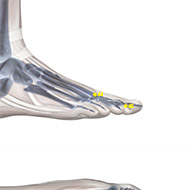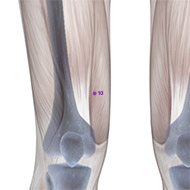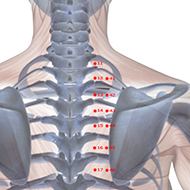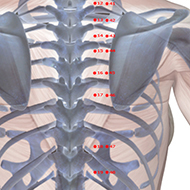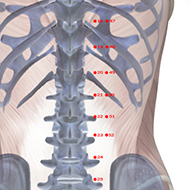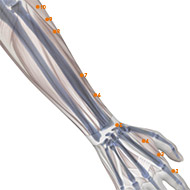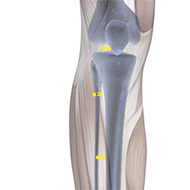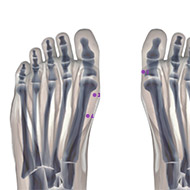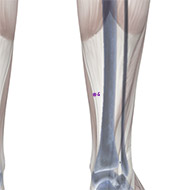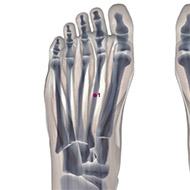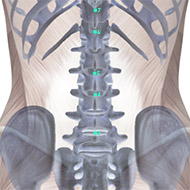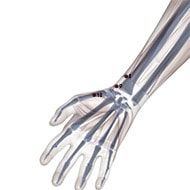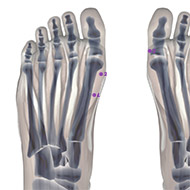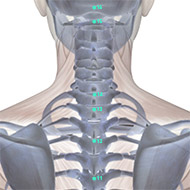Rated Acupoints
Acupuncture treatment for Acne
Rated Acupoints
2
Rated Acupoints
4
Rated Acupoints
3
Rated Acupoints
5
Rated Acupoints
7
Acne is a known chronic inflammatory condition which is very common and quite visible in the skin. This condition most commonly affects areas where the sebaceous glands are largest and most abundant such as the face, anterior trunk and upper back.1 Typical acne is characterized by comedones known also as blackheads, which are no more than dilated pores with a plug of keratin. Severe acne is characterized by whiteheads (small cream-colored, dome-shaped papules), red papules, pustules or cysts. Acne is very common, affecting 80% of young adults, 54% of adult women and 40% of adult men (mainly those in their early or mid-20s).2
CONTENTS
SYMPTOMS
CAUSES
TREATMENTS
SYMPTOMS
In fact, acne symptoms are different from one person to another. However, the most common include whiteheads, blackheads, small red and tender bumps, pimples, nodules and cystic lesions. 3
CAUSES
The real cause of acne is not clear, since there are many factors such as hormonal changes, heredity/genetics, drugs, cosmetics, alcohol, and smoking among others.4 At the same time, risk factors for the development of acne are not identified other than genetics; indeed secondary contributors include infections, diet, stress and smoking to some extent.5 Sunlight and cleanliness are not associated with acne.6
TREATMENTS
Typical acne treatment aimes at decreasing inflammation as well as alleviating discomfort while improving appearance and always preventing scarring and emotional distress.7 There are plenty of effective medications available for acne, although side-effects—such as local irritation, dry skin, high cholesterol, and increased risk of depression—are always a matter of concern.8 Over-the-counter preparations and herbal remedies are also common as well as skin- hygiene routines including dietary modifications are often prescribed.9 In addition to prescription medications, traditional chinese therapies are used to treat acne in many parts of Asia including China as well. One such therapy is acupoint stimulation. However, several methods can be applied: acupuncture with needles, moxibustion, which involves the controlled burning of material typically mugwort or Artemisia vulgaris herb, at certain points or areas of the body surface; cupping therapy, which involves applying suction by placing a vacuumed, usually by fire cup or jar on acupoints to increase blood flow or hemostasis; acupoint injection, which involves injecting medication into an acupuncture point and acupoint embedding, which involves embedding in the skin over the acupoint a small needle.10
Acupoint-stimulation methods are based on Traditional Chinese Medicine (TCM). TCM states that acne is caused by a combination of several pathogenic factors. These include intense lung heat or stomach heat, damp (humidity)–heat with blood stasis (congestion), and qi (vital energy or life force) stagnation (inactivity). As the condition continues, pathogenic heat rises and accumulates in the skin and tissues which brings on the lesions.11 Therefore, potential mechanisms of acupoint stimulation for acne include relieving heat toxicity, eliminating dampness (humidity), regulating the qi (life force) and blood, while always enhancing the immunologic function. Some studies also mention that acupuncture can stimulate and balance androgen (male hormone) levels to properly inhibit excess secretion of the sebaceous gland.12
Some known acne related acupuncture points include:
ST-2, ST-3, G-20, GV-24.5, BL-23, BL-10.
Other related acupuncture points include:
LI-11 LI-4 LU-5 LI-11 ST-44 GV-14 LI-11 SP-10 SP-9
Footnotes
- Treatment of acne with topical antibiotics: Lessons from clinical studies – Br J Dermatol – 2005, https://www.ncbi.nlm.nih.gov/pubmed/16086756
- Acne vulgaris: Review and guidelines – Dermatol Nurs – 2009, https://www.ncbi.nlm.nih.gov/pubmed/19507372
- Questions and answers about acne – National Institute of Arthritis and Musculoskeletal and Skin Diseases – 2016, https://www.niams.nih.gov/health-topics/acne
- Acne – patient.info – 2017, http://patient.info/health/acne-leaflet
- Epidemiology of acne vulgaris – BJD – 2013, https://www.ncbi.nlm.nih.gov/pubmed/23210645
- Acne Vulgaris in children and adolescents – Minerva Pediatrica – 2011, https://www.ncbi.nlm.nih.gov/pubmed/21909065
- Acne Vulgaris, II: Treatment – Cutis – 2002, https://www.ncbi.nlm.nih.gov/pubmed/19507372
- Acupoint Stimulation for Acne: A Systematic Review of Randomized Controlled Trials – Med Acupunct – 2013, https://www.ncbi.nlm.nih.gov/pmc/articles/PMC3689157/
- Acne Vulgaris – BMJ – 2002, https://www.ncbi.nlm.nih.gov/pubmed/12202330
- Acupoint Stimulation for Acne: A Systematic Review of Randomized Controlled Trials – Med Acupunct – 2013, https://www.ncbi.nlm.nih.gov/pmc/articles/PMC3689157
- Manual of Dermatology in Chinese Medicine: Acne and rosacea – Eastland Press – 1995, https://www.abebooks.com/Manual-Dermatology-Chinese-Medicine-Shen-De-Hui/208908522/bd
- Acupoint Stimulation for Acne: A Systematic Review of Randomized Controlled Trials – Med Acupunct – 2013, https://www.ncbi.nlm.nih.gov/pmc/articles/PMC3689157/
LU01
LU02
LU03
LU04
LU05
LU06
LU07
LU08
LU09
LU10
LU11
LI01
LI02
LI03
LI04
LI05
LI06
LI07
LI08
LI09
LI10
LI11
LI12
LI13
LI14
LI15
LI16
LI17
LI18
LI19
LI20
ST01
ST02
ST03
ST04
ST05
ST06
ST07
ST08
ST09
ST10
ST11
ST12
ST13
ST14
ST15
ST16
ST17
ST18
ST19
ST20
ST21
ST22
ST23
ST24
ST25
ST26
ST27
ST28
ST29
ST30
ST31
ST32
ST33
ST34
ST35
ST36
ST37
ST38
ST39
ST40
ST41
ST42
ST43
ST44
ST45
SP01
SP02
SP03
SP04
SP05
SP06
SP07
SP08
SP09
SP10
SP11
SP12
SP13
SP14
SP15
SP16
SP17
SP18
SP19
SP20
SP21
HT01
HT02
HT03
HT04
HT05
HT06
HT07
HT08
HT09
SI01
SI02
SI03
SI04
SI05
SI06
SI07
SI08
SI09
SI10
SI11
SI12
SI13
SI14
SI15
SI16
SI17
SI18
SI19
BL01
BL02
BL03
BL04
BL05
BL06
BL07
BL08
BL09
BL10
BL11
BL12
BL13
BL14
BL15
BL16
BL17
BL18
BL19
BL20
BL21
BL22
BL23
BL24
BL25
BL26
BL27
BL28
BL29
BL30
BL31
BL32
BL33
BL34
BL35
BL36
BL37
BL38
BL39
BL40
BL41
BL42
BL43
BL44
BL45
BL46
BL47
BL48
BL49
BL50
BL51
BL52
BL53
BL54
BL55
BL56
BL57
BL58
BL59
BL60
BL61
BL62
BL63
BL64
BL65
BL66
BL67
KD01
KD02
KD03
KD04
KD05
KD06
KD07
KD08
KD09
KD10
KD11
KD12
KD13
KD14
KD15
KD16
KD17
KD18
KD19
KD20
KD21
KD22
KD23
KD24
KD25
KD26
KD27
PC01
PC02
PC03
PC04
PC05
PC06
PC07
PC08
PC09
TB01
TB02
TB03
TB04
TB05
TB06
TB07
TB08
TB09
TB10
TB11
TB12
TB13
TB14
TB15
TB16
TB17
TB18
TB19
TB20
TB21
TB22
TB23
GB01
GB02
GB03
GB04
GB05
GB06
GB07
GB08
GB09
GB10
GB11
GB12
GB13
GB14
GB15
GB16
GB17
GB18
GB19
GB20
GB21
GB22
GB23
GB24
GB25
GB26
GB27
GB28
GB29
GB30
GB31
GB32
GB33
GB34
GB35
GB36
GB37
GB38
GB39
GB40
GB41
GB42
GB43
GB44
LV01
LV02
LV03
LV04
LV05
LV06
LV07
LV08
LV09
LV10
LV11
LV12
LV13
LV14
GV01
GV02
GV03
GV04
GV05
GV06
GV07
GV08
GV09
GV10
GV11
GV12
GV13
GV14
GV15
GV16
GV17
GV18
GV19
GV20
GV21
GV22
GV23
GV24
GV25
GV26
GV27
GV28
CV01
CV02
CV03
CV04
CV05
CV06
CV07
CV08
CV09
CV10
CV11
CV12
CV13
CV14
CV15
CV16
CV17
CV18
CV19
CV20
CV21
CV22
CV23
CV24




